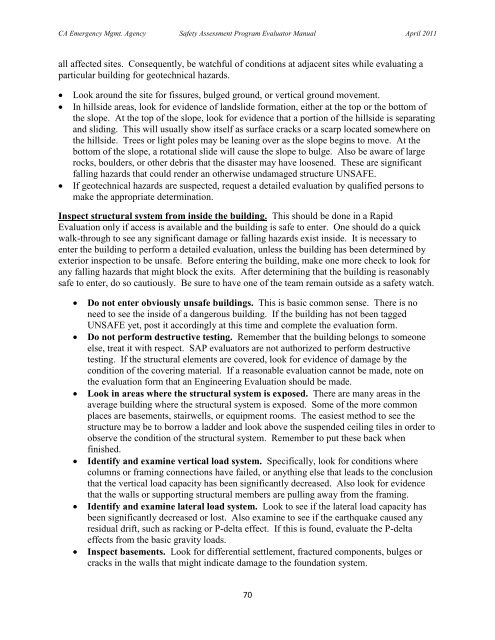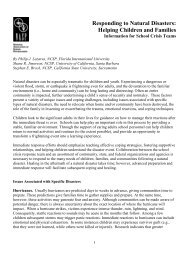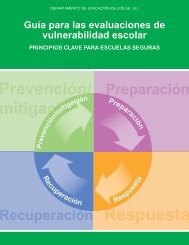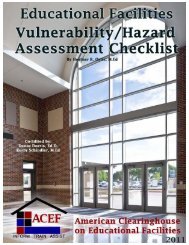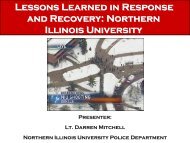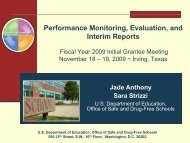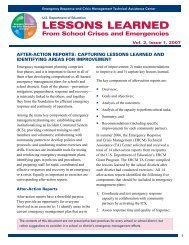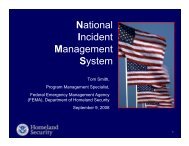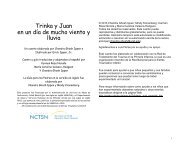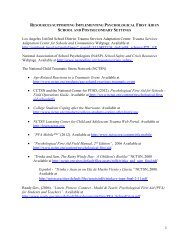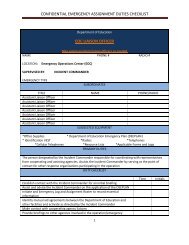Safety Assessment Program Evaluator Student Manual
Safety Assessment Program Evaluator Student Manual
Safety Assessment Program Evaluator Student Manual
Create successful ePaper yourself
Turn your PDF publications into a flip-book with our unique Google optimized e-Paper software.
CA Emergency Mgmt. Agency <strong>Safety</strong> <strong>Assessment</strong> <strong>Program</strong> <strong>Evaluator</strong> <strong>Manual</strong> April 2011all affected sites. Consequently, be watchful of conditions at adjacent sites while evaluating aparticular building for geotechnical hazards.Look around the site for fissures, bulged ground, or vertical ground movement.In hillside areas, look for evidence of landslide formation, either at the top or the bottom ofthe slope. At the top of the slope, look for evidence that a portion of the hillside is separatingand sliding. This will usually show itself as surface cracks or a scarp located somewhere onthe hillside. Trees or light poles may be leaning over as the slope begins to move. At thebottom of the slope, a rotational slide will cause the slope to bulge. Also be aware of largerocks, boulders, or other debris that the disaster may have loosened. These are significantfalling hazards that could render an otherwise undamaged structure UNSAFE.If geotechnical hazards are suspected, request a detailed evaluation by qualified persons tomake the appropriate determination.Inspect structural system from inside the building. This should be done in a RapidEvaluation only if access is available and the building is safe to enter. One should do a quickwalk-through to see any significant damage or falling hazards exist inside. It is necessary toenter the building to perform a detailed evaluation, unless the building has been determined byexterior inspection to be unsafe. Before entering the building, make one more check to look forany falling hazards that might block the exits. After determining that the building is reasonablysafe to enter, do so cautiously. Be sure to have one of the team remain outside as a safety watch.Do not enter obviously unsafe buildings. This is basic common sense. There is noneed to see the inside of a dangerous building. If the building has not been taggedUNSAFE yet, post it accordingly at this time and complete the evaluation form.Do not perform destructive testing. Remember that the building belongs to someoneelse, treat it with respect. SAP evaluators are not authorized to perform destructivetesting. If the structural elements are covered, look for evidence of damage by thecondition of the covering material. If a reasonable evaluation cannot be made, note onthe evaluation form that an Engineering Evaluation should be made.Look in areas where the structural system is exposed. There are many areas in theaverage building where the structural system is exposed. Some of the more commonplaces are basements, stairwells, or equipment rooms. The easiest method to see thestructure may be to borrow a ladder and look above the suspended ceiling tiles in order toobserve the condition of the structural system. Remember to put these back whenfinished.Identify and examine vertical load system. Specifically, look for conditions wherecolumns or framing connections have failed, or anything else that leads to the conclusionthat the vertical load capacity has been significantly decreased. Also look for evidencethat the walls or supporting structural members are pulling away from the framing.Identify and examine lateral load system. Look to see if the lateral load capacity hasbeen significantly decreased or lost. Also examine to see if the earthquake caused anyresidual drift, such as racking or P-delta effect. If this is found, evaluate the P-deltaeffects from the basic gravity loads.Inspect basements. Look for differential settlement, fractured components, bulges orcracks in the walls that might indicate damage to the foundation system.70


